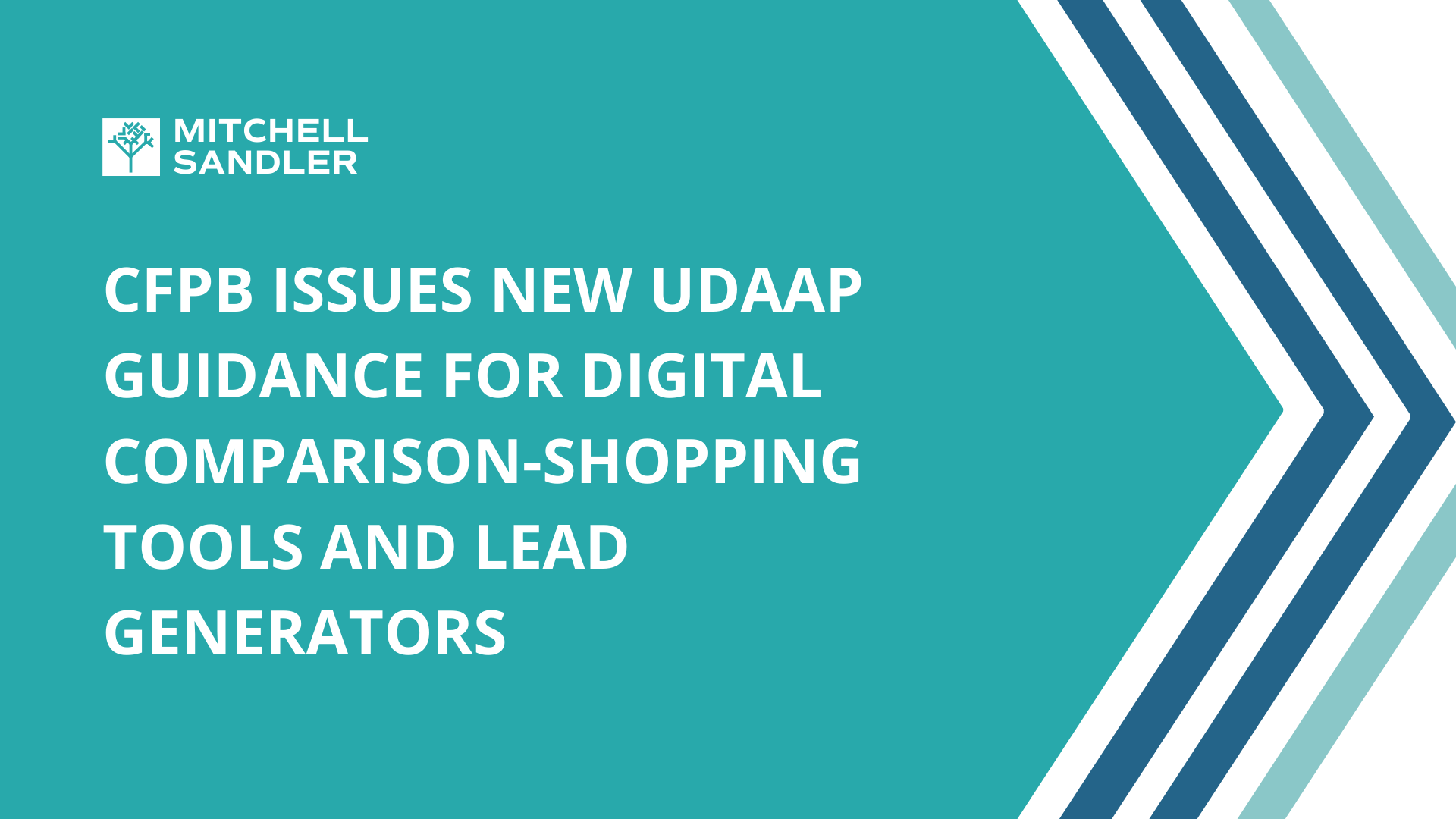CFPB Circular on Comparison Shopping Tools
The CFPB has issued new guidance on how digital comparison-shopping tools and lead generators can violate the “abusive” prong of UDAAP in violation of the Consumer Financial Protection Act (CFPA).
This is the latest guidance from the CFPB on compliance considerations for digital marketing providers and the abusiveness standard of UDAAP. Below is a summary of key aspects of the Circular and some best practices for mortgage lenders navigating these provider relationships.
Overview the UDAAP Circular
On February 29, 2024, the CFPB announced it issued Consumer Financial Protection Circular 2024-01: Preferencing and steering practices by digital intermediaries for consumer financial products or services (“UDAAP Circular”) to law enforcement agencies and regulators, asserting that manipulated comparison shopping sites are an example of “dark patterns” that can potentially violate consumer financial protection laws.
“Digital comparison-shopping tools” includes both tools that overtly recommend certain products as well as tools that have the effect of affirmatively influencing consumers’ likelihood of selecting or engaging with information about various consumer financial products and services, such as loans, credit cards, and savings accounts. Time or space advertising that is clearly set apart from the comparison shopping tools, like banner ads or pop-up ads, is not covered.
The CFPB focuses on one element of the abusiveness standard—taking unreasonable advantage of a consumer’s reasonable reliance on a covered person to act in the interests of the consumer—and describes how a violation can result from steering and preferencing practices based on financial or other benefits to the tool operator or lead generator.
To illustrate reasonable consumer reliance, the CFPB incorporates elements of the UDAAP analytical framework it published in its April 2023 Policy Statement on Abusive Acts and Practices, such as when a platform assumes the role of acting on behalf of consumers or helping them select products and services based on their interests. Reliance can also arise from explicit or implicit claims—e.g., that the provider has “expertise,” provides “research-based” rankings, or matches consumers with the “best” or “right” offers.
For a violation to occur, the consumer must reasonably rely on a “covered person” to act in their interest. Tool operators and lead generators can be covered persons because sometimes they extend or broker credit products, provide financial advisory services to consumers, or offer their own version of the consumer financial product or service consumers are seeking to compare. The CFPB tends to take a broad approach to “covered persons;” for example, in the fair lending context, marketing providers that meaningfully assist lenders in determining who their products or services will be offered to are “covered persons.”
Examples of Prohibited Preferencing or Steering Arrangements
Some examples of a tool operator or lead generator taking unreasonable advantage include:
Presenting a product in a more prominent placement, or in a way that is easier to access or makes the consumer more likely to select it, based on financial considerations or self-preferencing for products offered by the tool operator.
Listing options as “featured” because they are provided by the tool operator or by a third-party provider that paid for enhanced placement (however, if sponsored or advertising content is visually separate from recommendations, a consumer may be less likely to view the product as being presented in their interest).
Directing consumers to products that pay higher fees within a product category.
Presenting a product as a “match” based on financial or other benefits to the consumer, when the product is not most consistent with the expressed interests of the consumer.
When the tool operator’s payment is based on meeting volume allocations within a certain time period, steering to a particular provider to meet such volume allocations.
Lead generators that use dynamic bidding or bounty systems to determine which offers are presented to consumers with certain demographics or other characteristics.
Related CFPB Guidance Aimed at Digital Marketing Activities
The UDAAP Circular includes, but is not limited to, digital mortgage comparison shopping platforms addressed in the CFPB’s February 2023 Advisory Opinion (“RESPA Advisory Opinion”), warning that such platforms can violate Section 8 of RESPA by providing enhanced placement or otherwise steering consumers to certain participants based on compensation received from that participant rather than neutral criteria.
Examples of RESPA violations (which could also be UDAAP violations) include: 1) purporting to objectively match a consumer to suitable products, but instead steering to the highest bidder; 2) allowing lenders to pay to rotate into the top-ranked spot; 3) affiliate preferencing; and 4) warm handoffs that are not based on a consumer’s individual needs.
The UDAAP Circular applies to some digital marketing providers addressed in the CFPB’s 2022 Interpretive Rule describing how digital marketing providers could be considered service providers and therefore liable for CFPA violations.
Takeaways for Mortgage Lenders
Mortgage lenders often utilize third party comparison-shopping platforms and lead generators (collectively, “Providers”) as part of their marketing strategy. The CFPB expects lenders to demonstrate a process for managing the risks presented by third party service providers, including UDAAP risks, and may hold the lender responsible for a service provider’s violations. In addition, the CFPB can directly assert a RESPA Section 8 violation against a lender for prohibited payments to Providers.
Lenders can navigate regulatory risks associated with these relationships by adding the following to their existing framework for managing service providers:
Supplement vendor due diligence with a compliance review and risk assessment of each Provider. Since they can operate in a myriad of different ways (e.g., whether they collect consumer information, whether they purport to match or rank, how they display available lenders, whether they provide disclaimers), the RESPA and UDAAP risks of each provider will be fact-specific.
Determine how many other lenders the provider features on its site; the CFPB has stated that from both a RESPA and UDAAP standpoint, displaying a greater number of comparison options can help to decrease risk.
Confirm the provider has policies and procedures in place to comply with federal consumer financial law, including the RESPA Advisory Opinion and UDAAP Circular, and whether the provider has made changes to its platform, processes, layout, and/or website disclaimers in light of this guidance.
As with any service provider, ensure the contract establishes expectations regarding compliance, and outlines consequences for the violation of compliance-related responsibilities (including termination).
Review the specific services to be provided under the contract, and whether it calls for the lender to receive a specific placement or ranking.
Consider the proposed fees under the contract. The CFPB is critical of arrangements that involve a lender paying a bounty or bonus to the tool operator or lead generator based on directing consumers with particular characteristics, meeting volume criteria during a certain time period, or providing particular website placement. In addition, fees for lead sales need to comply with pre-existing RESPA best practices; for example, the lead fees should be a flat, per-lead amount and not conditioned on the success of the lead.
Consider other regulatory requirements such as consent to contact, privacy and information sharing practices, and state licensing. For example, some states require lead generators to be licensed, either with a specific lead generator license or a mortgage broker license. States will cite mortgage lenders in examinations for purchasing leads from unlicensed lead generators, so it is important to analyze the facts of the platform or lead provider and make an independent analysis of whether licensure is required.
About The Author
Allison Schilz is an attorney at Mitchell Sandler with experience helping clients comply with Consumer Financial Protection Bureau (CPFB) requirements, respond to supervisory examinations, and navigate consumer lending laws.
SIGN UP FOR UPDATES
Never miss our news, insights or events.
FEATURED NEWS




